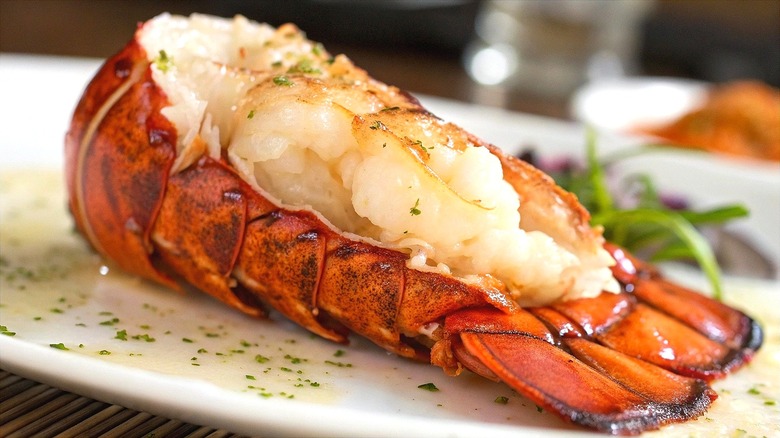Can You Cook Lobster Tails From Frozen?
If you're looking to upgrade your next homemade meal, consider preparing a favorite seafood variety like salmon, crawfish, or lobster instead of cooking ground beef or chicken. Since the difference between crawfish and lobster comes down to size, choose lobster when you want seafood to be the star of a fancy dinner at home. Better yet, you don't even need fresh lobster tails to create an impressive dish. Instead, rely on frozen lobster tails to craft a deliciously sophisticated meal.
However, preparing frozen, pre-packaged lobster tails requires a few essential steps. First and foremost, do not cook lobster tails straight from the freezer. While it may be tempting, doing so can result in tough and chewy seafood. For the best results, thaw frozen lobster tails properly to achieve a tender and satisfying texture.
Begin thawing a day in advance by placing the frozen tails on a baking sheet or in a bowl in your refrigerator up to 24 hours before mealtime. For a quicker thaw, place the tails in a sealed plastic bag and submerge the bag in a bowl of cold water. Change the water every 20 to 30 minutes for up to 90 minutes, or until the tails are fully thawed. Then, with the right cooking method, you'll enjoy tender, flavorful lobster tails in no time.
The right way to cook frozen lobster tails
After thawing and before cooking, gather your preferred seasonings and butterfly the lobster tails carefully to avoid hurting your fingers. To expose the meat, gently crack the tail shell with your thumb or cut it open using kitchen shears. For the most flavor, a great way to prepare previously frozen lobster tails is by poaching them in a rich liquid made of water, butter, and select spices. You can elevate your poaching liquid further by adding chopped garlic, fresh herbs, or citrus zest.
In a saucepan, bring a few tablespoons of water to a simmer and slowly incorporate cold butter, one tablespoon at a time. To avoid a broken sauce, add the butter gradually and ensure the poaching liquid does not exceed 190 degrees Fahrenheit. Use a food-grade thermometer and cook the lobster tails in the sauce until their internal temperature reaches 135 to 140 degrees Fahrenheit.
While poaching produces moist and flavorful tails, you can also steam or boil the lobster for similar results. Alternatively, bake, broil, or grill the tails for a more varied texture. Once the seafood is perfectly prepared, serve the lobster tails with freshly steamed corn on the cob, roasted root vegetables, or buttery mashed potatoes. Better yet, try upgrading your mashed potato recipe with miso and garlic for extra umami flavor.


